Why this comparison of God, the prophets, and the sons of God with the eagle? What do they have in common?
The reason is that the Eagle, as a bird, has special characteristics. It is the only bird that flies higher than all. Moreover, the higher he climbs, the better he sees. His sight is not dazzled by anything. He is powerful; he fears no wind, but on the contrary, he uses it to climb higher!
Eagle's eyes are a piecing gaze . Generally, predatory birds have a remarkable vision, but eagles are the best. Eagles can see eight times farther than humans and spot something from about 2 miles away! The eyesight of an eagle is 8 times sharper than a human’s eyesight.
The Scripture is as high as God Himself. Better, in Psalm 138:2, teaches us that God has exalted His Word above all His Name. Furthermore, in introducing his gospel, the apostle John confirms to us that the Word ( Logos in Greek) was in the beginning with God and that it was God (John 1:1);
This same God, who is the Word, according to the testimony of the apostle John, compares Himself to an eagle. Speaking to the people of Israel through Moses at the beginning of their exodus, He says: "... I bore you on eagles' wings and brought you to myself" (Exodus 19:4(b). Moses wants to show that God Himself alone takes care of His people, he says, "Like an eagle that watches over its nest..." The Lord alone led His people" (Deuteronomy 32:11-12).
Thus, God is called the "Great Eagle Jehovah," and He calls His prophets and His children eagles in turn. Matthew 24:28 says: "For wherever the dead body is, there the eagles will be gathered together." In other words, "wherever the word of God is freshly revealed for the age or the season, there the sons of God will be gathered together to believe it."
How Far
Can
an Eagle See?
[Exploring the
Limits of
Eagle’s
Vision]


Eagles are among the most
powerful birds of prey in the world
with their impressive wingspans
and beautiful plumage. But what’s
the farthest an eagle can see?
Generally, predatory birds have a
remarkable vision, but eagles are
the best. They can see eight times
farther than humans and spot
something from about 2 miles
away!
Here, we'll explore the limits of the
eagle’s vision and how sharp
eyesight helps the bird thrive in
the wild. Read on to discover more!
How Good is An
Eagle’s Eyesight?
The eyesight of a bald eagle is 8x
sharper than a human’s, and it can
see up to 2 miles away.

Adult eagle has incredible vision
and can spot prey and predators
from great distances. The eagle
flies high in the sky and uses its
sight to locate food and territory
intruders.
Eagles have remarkably sharp
vision because their eyes have two
foveae (areas of acute vision)
compared to just one fovea in
humans.
The eagles’ foveae cones are
extremely small and tightly
grouped, allowing them to see
small details from a great distance.
What Does an Eagle
Eye See?
Eagles use their peripheral vision
to see objects they can’t focus on
with central vision. This is because
they have a much wider field of
view than humans.

They can also see in color and
have sharper vision than humans
when it comes to identifying
objects like prey or predators.
An eagle’s two eyes provide it with
a nearly panoramic view. They can
see a squirrel running from over
two miles away.
The eagle’s eye also allows it to
see through ultraviolet light
perception and track a tiny prey
from the sky by the UV beams
reflected from its wet skin or urine.
What Makes an
Eagle’s Eyesight
so Exceptional?
Eagles have a 340-degree field of
vision because their eyes are
angled at 30 degrees from the
midline of their faces. They have
better peripheral vision than owls
but are not quite as sharp as a
woodcock, whose field of vision
unfolds up to 360 degrees.
How Does a Perfect
Eyesight Benefit
the Eagle?
Like many other birds of prey,
Eagles are equipped with keen
eyesight that helps them spot prey
from a distance and is one of their
main tools in hunting.
To hunt successfully, eagles need
the capability to see their food
from a long distance away before
attacking, meaning they must
have perfect eyesight.
The sharp eyesight also helps
them spot predators or intruders
from a far distance and hide or
prepare to protect their territory.
What Factors Hinder
an Eagle’s Ability to
See Far?
Like humans, eagles don’t have the
eyesight to see everything, and
certain factors hinder this sense.
Below are some of the factors that
hinder an eagle’s ability to see far:
- Pollution, especially dust,
- pollen, and other
- particulates in the air
- The weather conditions,
- especially when it’s foggy
- The eagle’s age. A chick or
- an overly old eagle can’t see
- far.
- The eagle’s health, including
- blindness in one eye
- Time of day
- The type of terrain
Can Eagles See
at Night?
Yes, eagles can see during the
nighttime; however, they can’t see
as well as we do due to a lack of
eye cells that help enhance
night vision.
Eagles are capable of flying at
night, but they can’t because of
their poor night vision.
Due to their lack of rod cells in their
eye retinas, they can’t see well in
the dark, but they might fly at night
if necessary.
Generally, eagles can’t see very
well in low-light conditions or at
dawn. Sometimes, eagles prefer to
use their sense of hearing
to find prey.
Can Eagles See
Ultraviolet Light?
Eagles can see in color and can
see more colors than humans.
They can see ultraviolet light,
aiding in hunting as they can see
their prey’s UV-absorbent urine.
However, this type of sight comes
with its drawbacks. Some
birdwatchers speculate that this
sensitivity is one reason eagles
don’t like daylight; it’s too bright
for them!
At Which Height
Can Eagle See?
Depending on what kind of eagle,
they could reach altitudes 10,000
to 20,000 feet above sea level.

From this viewpoint, the eagle’s
superb vision allows it to spy on
prey or predators from a
far distance.
Eagles can fly as high as 10,000
feet at 100 miles per hour and dive
into prey at a speed of about
150 mph! (241.4016 kmph)
( 1 mph = 1.609344 kmph)
However, at these heights, there’s
less oxygen available for the eagle,
and flying becomes more difficult,
meaning it won’t stay there for a
prolonged time.
Which Eagle has
the Best Vision?
Generally, the truth is that bald
eagle has better vision than other
eagles. Its acuity is approximately
7 to 8 times greater than a human’s.
An excellent illustration of the
popular phrase “eagle eye” is the
bald eagle.
There are many eagles in the world,
each with a different vision. But
when it comes to which eagle has
the best vision, that is up for
debate.
Some birdwatchers think American
bald eagles have better sight than
golden eagles because they can
see things from a greater distance.
Others say golden eagles have
better eyesight because they can
easily spot prey. The bottom line is
that all eagles have exceptional
eyesight!
Who has Better
Eyesight, Hawk or
Eagle?
Although their vision differs in
terms of depth and magnification,
eagles and hawks can see things
at 20 feet.
However, in terms of the best
eyesight, hawks can spot prey
from further away than other eagle
species except for the bald eagle.
For example, a hawk with a visual
acuity of 1.6 can spot prey from 2
miles away, while an eagle with a
visual acuity of 3.2 can spot prey
from over 1 mile away.
(1.609344 kilometers)
Are the Eagle Eyes
Bigger than Humans?
Eagle eyes are not only beautiful
because they’re piercing but also
because they’re so large.
An eagle’s eyes are the same size
and weight as human eyes but
usually weigh around 10 pounds
(4.5kg).
Their larger eyes have more light-
sensitive cells that can detect and
process more information than
smaller ones.
Can an Eagle See a
Vole from Two Miles
Away?
An eagle can probably see a vole
from about two miles away, but it
depends on what kind of vole.
Voles are small rodents that are
relatives of lemmings and
hamsters, but with a stouter body;
a longer, hairy tail; a slightly
rounder head; smaller eyes and
ears; and differently formed
molars.
If we’re talking about a big mouse,
then yes. But if we’re talking about
a small rat, it could be much
farther away and still be visible to
the eagle.
Generally, the vole’s UV-absorbent
urine reflects the light, which helps
the eagle to spot the animal easily
from a huge distance.
Can Eagles See with
their Eyes Closed?
One of the eagle’s most extra-
ordinary eyesight features is that it
can see even with closed eyelids.
Not only does the eagle have the
normal eyelids found on any
animal, but it has another pair
called nictitating membranes.
These eyelids can be shut without
affecting the eagle’s vision.
These membranes are transparent
and wet and work like goggles
underwater to protect the eagle’s
eyes from debris, dust, or animal
attack.
When hunting, the eagle will close
these additional eyelids so that he
can more easily focus on catching
prey with his talons rather than
keeping his eyes safe.
The Most Common Misconceptions
About Eagle’s
Eyesight
The most common misconception
about eagles is that they can see
up to 10 miles away.
This figure has been widely cited as
fact for many years, but more
recent reflections have shown it to
be much less than that. Generally
about 2 miles on a good day!
68 Types
of Eagles
(4 Groups) Complete
Guide to
All
Species
How many eagle species
can you name? Perhaps the
bald eagle comes to mind.
Here, you’ll learn about all 68
species of eagles found
around the world.
They are organized into four
different groups from two
subfamilies and 23 genera.
Learn about where they’re
from and their population
status.
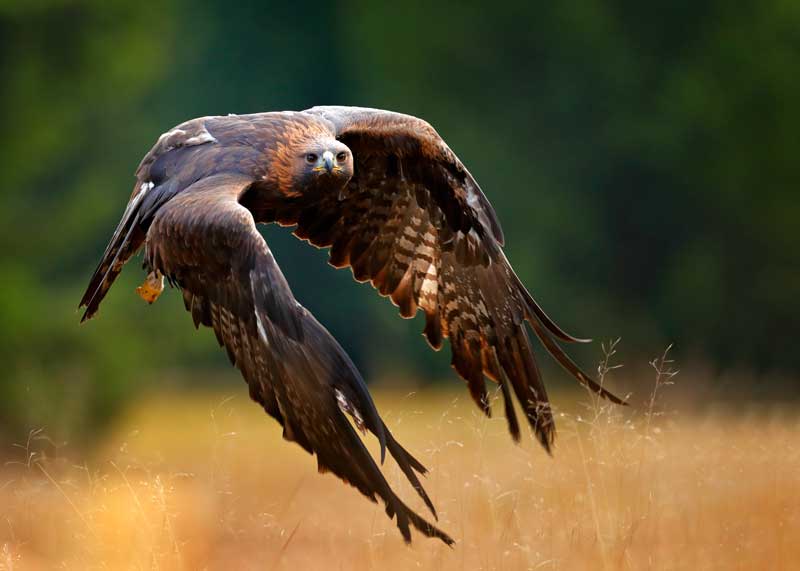
Guide to 68 Types of Eagles
How many species of eagles are there?
There are 23 genera of
eagles, subdivided into 68
different species of eagles.
For more information on
each of these species,
please keep reading.
4 Different Groups of Eagles
You will often see eagles
divided into 4 different
groups. These groups are
informal and not part of the
official classification system.
These group classifications
are also not exclusive - so
just because an eagle has
been put into the “Snake
Eagle” category, that doesn’t
mean it won’t eat the
occasional fish.
Along the same lines, “Fish
Eagles” or Sea Eagles” may
also be found further inland.
Subfamily Circaetinae
1. Snake
Eagles or
Serpent
Eagles
- Family: Accipitridae
- Subfamily: Circaetinae
- Genera: Circaetus,
- Dryotriorchis, Eutriorchis,
- Spilornis, and Terathopius
These eagles are pros when
it comes to catching snakes
and other reptiles.
They often make their
homes in deserts or forested
areas where this prey is
abundant.
Subfamily Buteoninae
Some researchers classify
all of the rest of the eagles
under the subfamily
Buteoninae. Others propose
that this large subfamily
should actually be broken
into 3 smaller subfamilies.
These 3 proposed sub-
families are the following:
2. Fish Eagles
or Sea Eagles
- Family: Accipitridae
- Proposed Subfamily: Haliaeetinae
- Genera: Haliaeetus, and Icthyophaga
As indicated by their name,
eagles in this category are
excellent fishers. You will
often find them in coastal
areas, although some can
be found further inland.
3. Booted Eagles, Hawk-Eagles, and Buzzard-Eagles
- Family: Accipitridae
- Proposed Subfamily:
- Aquililae
- Genera: Aquila,
- Geranoaetus,
- Hieraaetus,
- Ictinaetus, Lophoaetus,
- Lophotriorchis,
- Nisaetus, Polemaetus,
- Spizaetus, and
- Stephanoaetus
- Other Genera: Clanga
This group is also referred
to as “true eagles.” Eagles
in this group have feathers
on their lower legs ending
at their feet.
4. Harpy Eagles
- Family: Accipitridae
- Proposed Subfamily: Harpiinae
- Genera: Harpia, Harpyosis,
- and Morphnus
- Other Genera: Buteogallus,
- and Pithecaphaga
Harpy eagles are giant,
forest-dwelling eagles.
The eagles placed in this
group vary, depending on
who you ask.
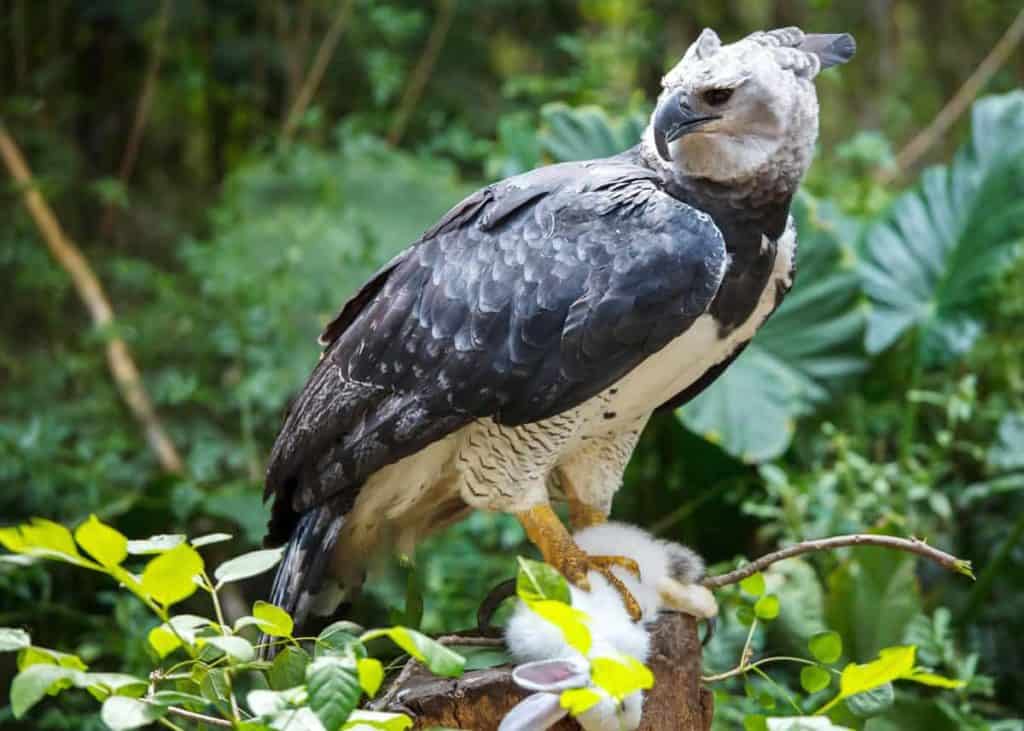
68 Eagle Species (within 23 genera)
There are currently 68
different species of eagles.
The classifications below
are up to date at time of
publishing, including
changes made within the
last few years. Click here.
As a disclaimer, new
research has shown that
some eagle species once
placed into the same sub-
families are not as closely
related as once thought. As
a result, there may be a
major reclassification of the
eagle subfamilies and
genera at some point.
For example, Bonelli’s Eagle
used to be in the Hieraaetus
genus. It has since been
moved to the Aquila genus.
Genus: Aquila (11 species)
| Eagle | Scientific Name | Location | Population Status |
| African Hawk-Eagle | Aquila spilogaster | Africa | Least Concern |
| Bonelli’s Eagle | Aquila fasciata | Europe, Asia, and Africa | Near Threatened |
| Cassin’s Hawk-Eagle | Aquila africana | Africa | Least Concern |
| Eastern Imperial Eagle | Aquila heliaca | Europe, Asia, and Africa | Vulnerable |
| Golden Eagle | Aquila chrysaetos | North America, Europe, Asia, and Africa | Least Concern |
| Gurney’s Eagle | Aquila gurneyi | Asia, and Oceania (Indonesia, and Papua New Guinea) | Near Threatened |
| Spanish Imperial Eagle | Aquila adalberti | Europe (Spain, and Portugal) | Vulnerable |
| Steppe Eagle | Aquila nipalensis | Europe, Asia, and Africa | Critically Endangered |
| Tawny Eagle | Aquila rapax | Asia, and Africa | Vulnerable |
| Verreaux’s Eagle | Aquila verreauxii | Asia, and Africa | Least Concern |
| Wedge-Tailed Eagle | Aquila audax | Oceania (Australia) | Least Concern |

Genus: Buteogallus
(2 species)
| Eagle | Scientific Name | Location | Population Status |
| Black Solitary Eagle | Buteogallus solitarius | Central and South America | Near Threatened |
| Crowned Solitary Eagle | Buteogallus coronatus | South America | Endangered |
Genus: Circaetus
(6 species)
| Eagle | Scientific Name | Location | Population Status |
| Beaudouins’s Snake-Eagle | Circaetus beaudouini | Africa | Vulnerable |
| Black-Chested Snake-Eagle | Circaetus pectoralis | Africa | Least Concern |
| Brown Snake-Eagle | Circaetus cinereus | Africa | Least Concern |
| Short-Toed Snake-Eagle | Circaetus gallicus | Europe, Asia, and Africa | Least Concern |
| Southern Banded Snake-Eagle | Circaetus fasciolatus | Africa | Near Threatened |
| Western Banded Snake-Eagle | Circaetus cinerascens | Africa | Least Concern |
Genus:
Clanga
(3 species)
| Eagle | Scientific Name | Location | Population Status |
| Greater Spotted Eagle | Clanga clanga | Europe, Asia, and Africa | Vulnerable |
| Indian Spotted Eagle | Clanga hastata | Asia | Vulnerable |
| Lesser Spotted Eagle | Clanga pomarina | Europe, and Africa | Least Concern |
Genus:
Dryotriorchis
(1 species)
| Eagle | Scientific Name | Location | Population Status |
| Congo Serpent-Eagle | Dryotriorchis spectabilis | Africa | Least Concern |
Genus: Eutriorchis (1 species)
| Eagle | Scientific Name | Location | Population Status |
| Madagascar Serpent-Eagle | Eutriorchis astur | Africa (Madagascar) | Endangered |
Genus: Geranoaetus (1 species)
| Eagle | Scientific Name | Location | Population Status |
| Black-Chested Buzzard-Eagle | Geranoaetus melanoleucus | South America | Least Concern |
Genus: Haliaeetus (8 species)
| Eagle | Scientific Name | Location | Population Status |
| African Fish-Eagle | Haliaeetus vocifer | Africa | Least Concern |
| Bald Eagle | Haliaeetus Ieucocephaus | North America | Least Concern |
| Madagascar Fish-Eagle | Haliaeetus vociferoides | Africa (Madagascar) | Critically Endangered |
| Pallas’s Fish-Eagle | Haliaeetus leucoryphus | Asia | Endangered |
| Sanford’s Sea-Eagle | Haliaeetus sanfordi | Oceania (Papua New Guinea, and the Solomon Islands) | Vulnerable |
| Steller’s Sea-Eagle | Haliaeetus pelagicus | Asia | Vulnerable |
| White-Bellied Sea-Eagle | Haliaeetus leucogaster | Asia, and Oceania | Least Concern |
| White-Tailed Sea-Eagle | Haliaeetus albicilla | Europe, and Asia | Least Concern |
Genus:
Harpia (1 species)
| Eagle | Scientific Name | Location | Population Status |
| Harpy Eagle | Harpia harpyja | Central and South America | Near Threatened |
Genus: Harpyopsis (1 species)
| Eagle | Scientific Name | Location | Population Status |
| Papuan Eagle | Harpyopsis novaeguineae | Asia, and Oceania (Indonesia, and Papua New Guinea) | Vulnerable |
Genus: Hieraaetus (5 species)
| Eagle | Scientific Name | Location | Population Status |
| Ayres’s Hawk-Eagle | Hieraaetus ayresii | Africa | Least Concern |
| Booted Eagle | Hieraaetus pennatus | Europe, Asia, and Africa | Least Concern |
| Little Eagle | Hieraaetus morphnoides | Oceania (Austrailia) | Least Concern |
| Pygmy Eagle | Hieraaetus weiskei | Asia, and Oceania (Indonesia, and Papua New Guinea) | Least Concern |
| Wahlberg’s Eagle | Hieraaetus wahlbergi | Africa | Least Concern |
Genus: Icthyophaga
(2 species)
| Eagle | Scientific Name | Location | Population Status |
| Grey-Headed Fish-Eagle | Icthyophaga ichthyaetus | Asia | Near Threatened |
| Lesser Fish-Eagle | Icthyophaga humilis | Asia | Near Threatened |
Genus: Ictinaetus (1 species)
| Eagle | Scientific Name | Location | Population Status |
| Black Eagle | Ictinaetus malaiensis | Asia | Least Concern |
Genus: Lophaetus (1 species)
| Eagle | Scientific Name | Location | Population Status |
| Long-Crested Eagle | Lophaetus occipitalis | Africa | Least Concern |
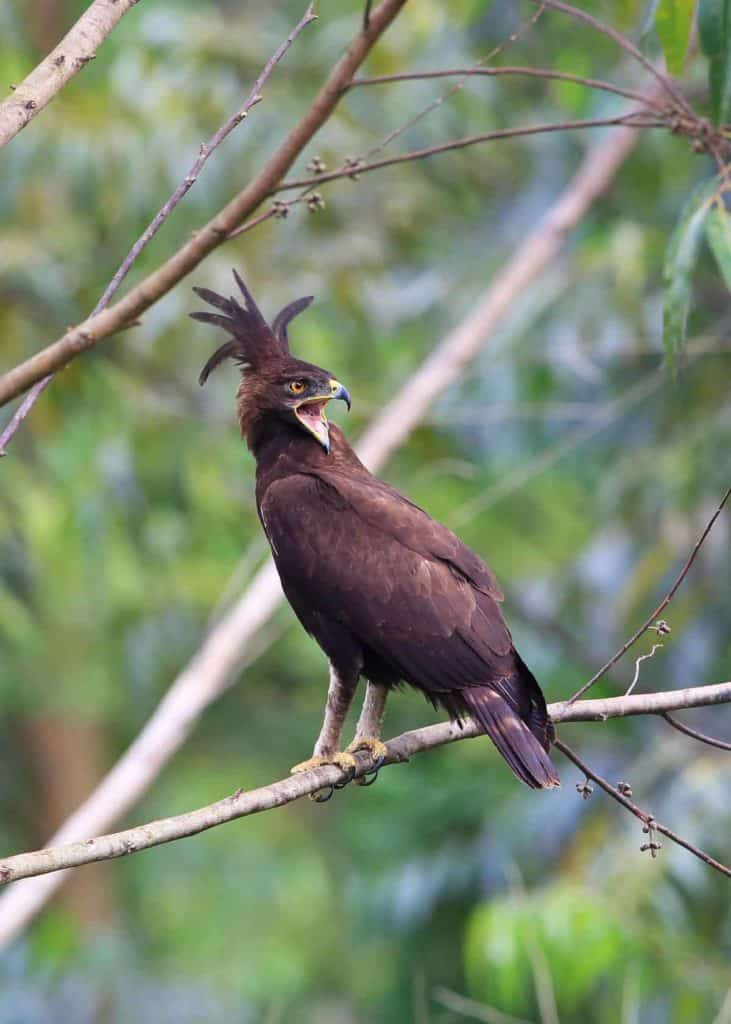
Genus: Lophotriorchis (1 species)
| Eagle | Scientific Name | Location | Population Status |
| Rufous-Bellied Eagle | Lophotriorchis kienerii | Asia | Near Threatened |
Genus: Morphnus (1 species)
| Eagle | Scientific Name | Location | Population Status |
| Crested Eagle | Morphnus guianensis | Central and South America | Near Threatened |
Genus:
Nisaetus
(9 species)
| Eagle | Scientific Name | Location | Population Status |
| Blyth’s Hawk-Eagle | Nisaetus alboniger | Asia | Least Concern |
| Changeable Hawk-Eagle | Nisaetus cirrhatus | Asia | Least Concern |
| Flores Hawk-Eagle | Nisaetus floris | Asia (Indonesia) | Critically Endangered |
| Javan Hawk-Eagle | Nisaetus bartelsi | Asia (Indonesia) | Endangered |
| Mountain Hawk-Eagle | Nisaetus nipalensis | Asia | Least Concern |
| North Philippine Hawk-Eagle | Nisaetus philippensis | Asia (Northern Philippines) | Endangered |
| South Philippine Hawk-Eagle | Nisaetus pinskeri | Asia (Southern Philippines) | Endangered |
| Sulawesi Hawk-Eagle | Nisaetus lanceolatus | Asia (Indonesia) | Least Concern |
| Wallace’s Hawk-Eagle | Nisaetus nanus | Asia | Vulnerable |
Genus: Pithecophaga
(1 species)
| Eagle | Scientific Name | Location | Population Status |
| Philippine Eagle | Pithecophaga jefferyi | Asia (the Philippines) | Critically Endangered |
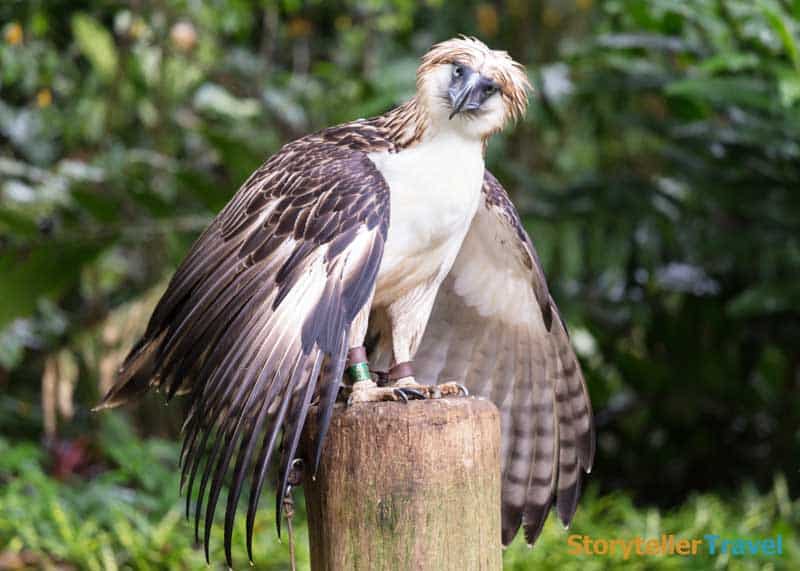
Genus: Polemaetus (1 species)
| Eagle | Scientific Name | Location | Population Status |
| Martial Eagle | Polemaetus bellicosus | Africa | Endangered |
Genus:
Spilornis
(5 species)
| Eagle | Scientific Name | Location | Population Status |
| Andaman Serpent-Eagle | Spilornis elgini | Asia (Andaman Islands, India) | Vulnerable |
| Crested Serpent-Eagle | Spilornis cheela | Asia | Least Concern |
| Great Nicobar Serpent-Eagle | Spilornis klossi | Asia (Nicobar Island, India) | Near Threatened |
| Kinabalu Serpent-Eagle | Spilornis kinabaluensis | Asia | Vulnerable |
| Philippine Serpent-Eagle | Spilornis holospilus | Asia (the Philippines) | Least Concern |
Genus: Spizaetus (4 species)
| Eagle | Scientific Name | Location | Population Status |
| Black Hawk-Eagle | Spizaetus tyrannus | Central and South America | Least Concern |
| Black-and-Chestnut Eagle | Spizaetus isidori | South America | Endangered |
| Black-and-White Hawk-Eagle | Spizaetus melanoleucus | Central and South America | Least Concern |
| Ornate Hawk-Eagle | Spizaetus ornatus | Central and South America | Near Threatened |
Genus: Stephanoaetus (1 species)
| Eagle | Scientific Name | Location | Population Status |
| Crowned Eagle | Stephanoaetus coronatus | Africa | Near Threatened |
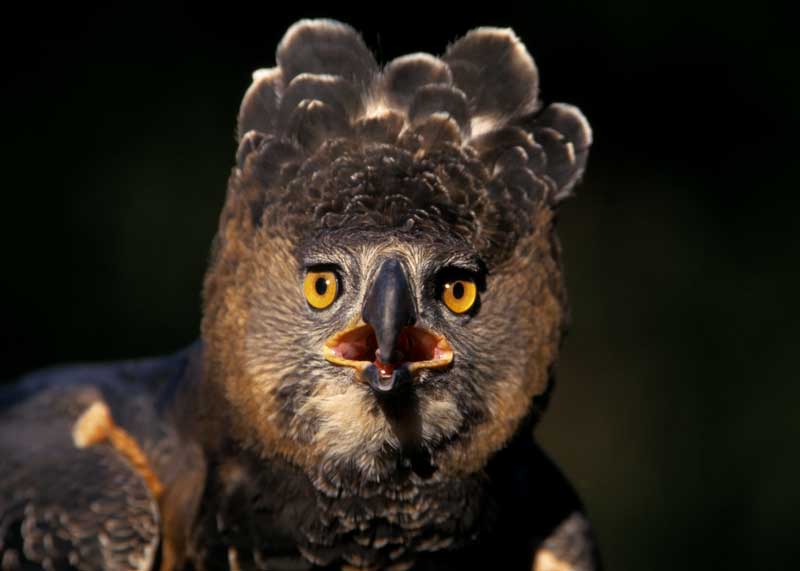
Genus: Terathopius (1 species)
| Eagle | Scientific Name | Location | Population Status |
| Bateleur | Terathopius ecaudatus | Africa | Endangered |
Love watching birds? Check
out our guide to the best
compact binoculars for
hikers and birders.
Common Questions About
Eagles
Here are the answers to
common questions about
eagles.
What is an eagle?
Eagles are large and power-
ful birds of prey. They have
hooked beaks, strong legs,
and sharp talons.
They are in the scientific
family “Accipitridae.”
Are hawks a type of eagle
?
No, hawks are not a type of
eagle. While a few of the
species of eagles are called
“Hawk-Eagles,” eagles and
hawks are not the same.
Eagles are generally larger,
and stronger- and therefore
feed on larger prey animals.
Eagles are also larger than
falcons.
Where can
they be
found?
Eagles can be found on
every continent except for
Antarctica. You can see the
location of each of the
species in the tables here:-
Genus: Aquila (11 species)
Eagle @Location:Status
1.African Hawk-Eagle
@Africa:Least Concern
2.Bonelli’s Eagle @Europe,
Asia & Africa:Near
Threatened
3.Cassin’s Hawk-Eagle
@Africa:Least Concern
4.Eastern Imperial Eagle
@Europe, Asia & Africa
:Vulnerable
5.Golden Eagle @North
America, Europe, Asia &
Africa:Least Concern
6.Gurney’s Eagle @Asia &
Oceania (Indonesia, and
Papua New Guinea): Near
Threatened
7.Spanish Imperial Eagle
@Europe (Spain & Portugal
):Vulnerable
8.Steppe Eagle @Europe,
Asia & Africa: Critically
Endangered
9.Tawny Eagle @Asia &
Africa: Vulnerable
10.Verreaux’s Eagle @Asia
& Africa: Least Concern
11.Wedge-Tailed Eagle
@Oceania (Australia):
Least Concern
Genus: Buteogallus
(2 species)
Eagle @Location:Status
12.Black Solitary Eagle
@Central & South America
:Near Threatened
13.Crowned Solitary Eagle
@South America
:Endangered
Genus: Icthyophaga
(2 species)
14.Grey-Headed Fish-Eagle
@Asia: Near Threatened
15.Lesser Fish-Eagle
@Asia: Near Threatened
Genus: Ictinaetus
(1 species)
16.Black Eagle @Asia:
Least Concern
Genus: Lophaetus
(1 species)
17.Long-Crested Eagle
@Africa: Least Concern
What is the
biggest
eagle?
- Based on Weight:
- Steller’s Sea-Eagle,
- 14.75 pounds
- (6.7 kilograms)
- Based on Total Length: Philippine Eagle,
- 3 feet 3 inches
- (100 centimeters)
- Based on Wingspan:
- White-Tailed Sea-Eagle
- 7 feet 2 inches
- (218.5 centimeters)
Learn more about the
largest eagles in the world.
Click here .
What is the
smallest
eagle?
The smallest eagle is the
Great Nicobar Serpent-
Eagle. It weighs 1 pound
(450 grams) and has a
body length of 15.7 inches
(40 centimeters).
Are eagles endangered?
Here are how the 68 eagles
rank on the IUCN Red List:
- Least Concern:
- 31 species
- Near Threatened:
- 12 species
- Vulnerable: 12 species
- Endangered: 9 species
- Critically Endangered:
- 4 species
Did you know? Eagles mate
for life. Learn about 28
other animals that also
mate for life.
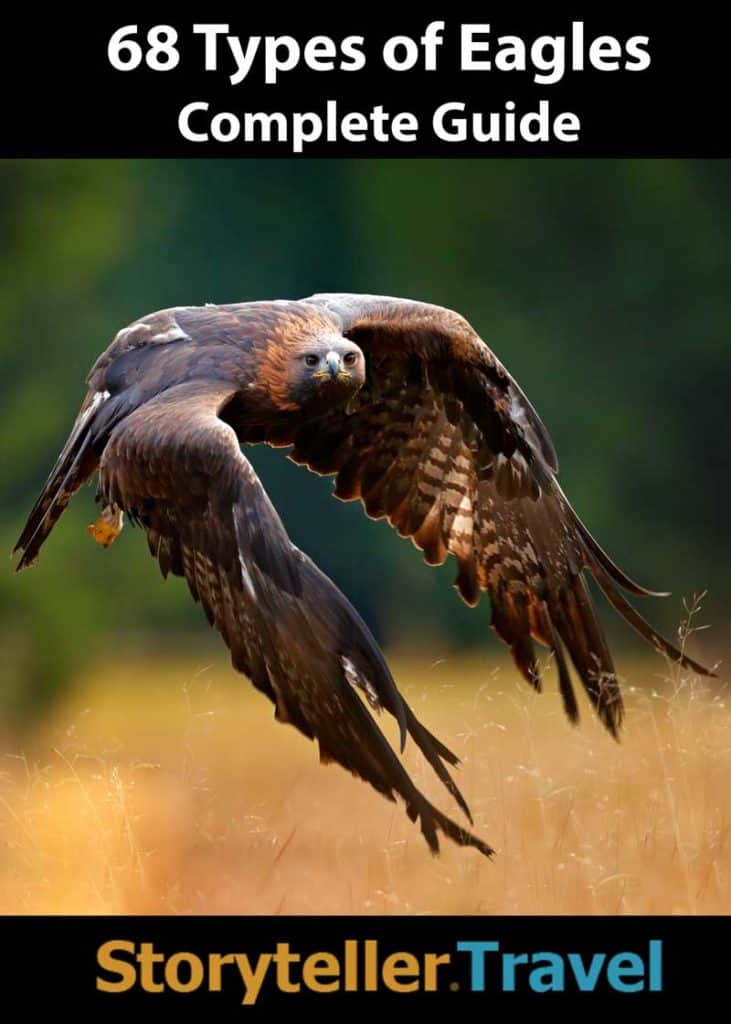
More prophetic here
No comments:
Post a Comment